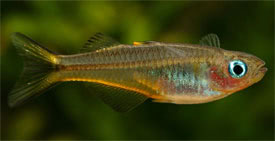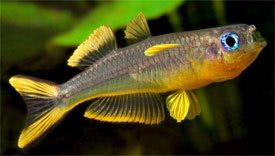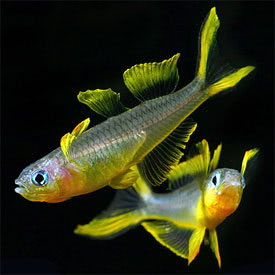
 Magyarul / Hungarian
Magyarul / Hungarian



- Scientific name: Popondichthys furcatus
- Synonyms: Popondetta furcata, Pseudomugil furcatus
- Common name: Forktail rainbowfish, Forktail Blue-eye
- Group: Rainbowfish
- Habitat: Asia; Papua New Guinea
- Size: 5-6 cm
- Biotope: Inhabits in relatively swift-flowing, clear rainforest streams, with dense aquatic vegetation.
- Social behavior: Peaceful, active schooling fish. Can be kept with other small, peaceful species such as danios, small tetras and rasboras.
- Diet: Omnivorous; predominantly small live and frozen foods, also eats flake foods.
- Breeding: Quite easy
- Tank: Minimum 60 litres
- Population: 6-8 fish for 70 litres
- Decoration: Densely planted aquarium, with some floating plants.
- Temperature: 24-28°C
- pH: 7-8
- Hardness: 5-12 NK°
- Lifespan: 3-6 years
Description: Males can be sometimes agressive towards females, so keep them in groups with more females. They have two dorsal fins, separated by a small gap, the first much smaller than the second. The body colour is yellow-green, and the dorsal and anal fins of the males are transparent with narrow yellow margins, while the females have transparent pectoral and pelvic fins. The caudal fin is yellowish, and deeply forked. They have beautiful blue eyes.
The males have a longer first dorsal fin, and they are larger and more intense colored, and they have a bright orange colored chest. They are egg scatterers. Spawn them in groups, with a ratio of 2-3 males to 8-10 females. Clumps of fine leaved plants can be used as a spawning medium, such as Java moss. The females will lay only a few, about 5 to 10 eggs a day. The eggs are adhesive and will stick to the plants. Remove eggs and put them into a small container. The eggs will hatch in 10-15 days. At this point the tiny fry can be moved to a larger tank with shallow water. The fry should be fed infusoria or liquid fry food for the first week, because they are small. After the first week they can be fed with artemia nauplii. Regular small water changes are essential. The fry grow very rapidly.


























